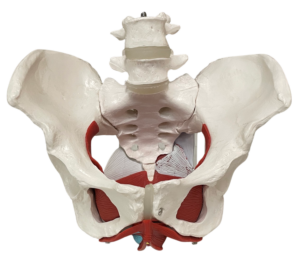Are you currently pregnant? Have you ever heard the term pelvic floor? Could you even locate or describe it on your own body if asked? Though access to information continues to grow, the pelvic floor is still an often overlooked and misunderstood area of the body. This lack of knowledge surrounding our bodies can be particularly troublesome for women during pregnancy. The pelvic floor, while vital to many aspects of health for all people, becomes increasingly relevant during pregnancy, labor/delivery, and postpartum periods. Today, we will be focusing on the pelvic floor and its role during pregnancy, as well as labor and delivery. Let us dive in and talk about 3 aspects of your pelvic floor to be aware of during pregnancy:
1. What the heck is a pelvic floor?

Your pelvic floor is a group of muscles that sits like a bowl at the base of your pelvis. These muscles act like a trampoline to help absorb and respond to forces placed on your system throughout your day. Proper mobility, strength, and coordination of these muscles are imperative for proper bowel/bladder function, sexual health, core stability, and pressure management throughout your system. Awareness of what these muscles look like and how they function is the first step to connecting with this area of your body. This connection is critical to be able to understand and control this very unique part of your body.
2. Common pelvic floor dysfunction during pregnancy
During pregnancy, the entire body encounters many changes. Some of these can include changes to the structure and function of your pelvic floor and surrounding areas. Increased pressure from your abdomen, as well as increased laxity of your joints, can lead your pelvic floor to respond in several different ways. Some people will demonstrate increased tension, while others will demonstrate lengthening and weakening of the pelvic floor muscles. Either way, the muscles will not be functioning appropriately. This can lead to many symptoms, including urinary leakage, pain with intercourse, back pain, pelvic pain, round ligament pain, and more.
Being aware of your pelvic floor and its role in many of these common pregnancy symptoms can help you regain a sense of control over your body, as well as direct you on the right path toward necessary treatment. While many of these symptoms are common during pregnancy, you do not have to suffer through them. There are providers who can help (more on that to come).
3. The pelvic floor and its role in labor/delivery
This is the most commonly misunderstood role of the pelvic floor. For many years, women have been instructed to hold their breath and bear down when they feel a contraction. This concept has been commonly referred to as “purple” pushing due to the discoloration that often occurs in the face. Unfortunately, this cueing often leads the pelvic floor to activate and tense up, the opposite of what they’re designed for. This forceful pushing is likely associated with increased tearing rates, need for mechanical interventions, and a more difficult postpartum recovery.
The pelvic floor’s true role during labor is to relax and open up. This helps the progression of labor by allowing mobility throughout the pelvis as baby is navigating through the birth canal. Relaxing your pelvic floor also allows the uterus, the main pusher, to work more effectively in progressing the baby during contractions. Controlled breathing, with a focus on low-tone exhalation, can help facilitate proper pelvic floor muscle relaxation. Taking a birthing class through a certified doula or midwife group can help provide more in-depth information about breathwork during labor.
What is pelvic floor PT, and how can it help?
This is all great information, but how can pelvic floor therapy help me? Good question. Pelvic floor PTs are physical therapists who have had in-depth training in the diagnosis and treatment of pelvic floor dysfunction. A pelvic PT can help address pain and symptoms that occur during your pregnancy. We guide you through a series of different hands-on treatments and exercise prescriptions tailored to your specific condition. A pelvic PT can also help provide further education on the pelvic floor and its role in labor/delivery to help prep your body and aid in reducing the risk of things like tearing and use of medical interventions such as forceps or vacuums.
If you have any questions or would like more information, feel free to give us a call or send us a message. We would love to hear from you!





